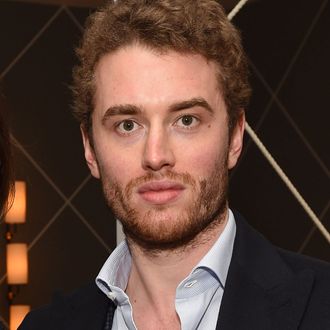
Inigo Phibrick, dubbed the “mini-Madoff” of the art world following claims that he resold the same artwork to multiple buyers, pleaded guilty on Thursday to one count of wire fraud in Manhattan federal court. “I knew my actions were wrong and illegal,” Philbrick told judge Sidney Stein.
Philbrick told Stein that from around 2016 to 2019, he “knowingly engaged” in a scheme to make money, using “material misrepresentations and omissions” in his business dealings. That included selling more shares in an artwork than existed, Philbick said.
“Why did you do this?” Stein asked.
“For money, your honor.”
“That simple?”
“That simple,” Philbrick replied.
Stein asked Philbrick why Philbrick needed the money.
He told the judge that he was trying to build his business and “needed money for that.” Philbrick also agreed to cough up more than $86 million in money connected to his crimes.
The 34-year-old was matter-of-fact as he addressed Stein. Philbrick, who had shackles around his ankles, was wearing a khaki jail shirt and institutional navy pants. His hair had grown out into a sort of curly mullet. Prior to the proceeding, Philbrick looked toward a modelesque blonde who was seated in the front row, and raised his eyebrows at her in a playful greeting.
The well-connected young art dealer, who had disappeared two years ago after allegations of double-dealing artworks surfaced, was arrested in June 2020 on the South Pacific island nation of Vanuatu. Philbrick was charged with wire fraud and aggravated identity theft in an alleged $20 million “scheme,” federal prosecutors said.
Federal agents nabbed Philbrick after Vanuatu officials “expelled” him from the country, a move that came “at the request of the U.S. Embassy in Papua New Guinea in light of the charges in the Complaint.” Philbrick was then transported to Guam, where a judge greenlighted his transfer to New York City.
Flight records indicated that Philbrick departed the United States just before reports on lawsuits against him surfaced. Vanuatu told U.S. authorities that Philbrick had been living on the island since about late October 2019, the feds said.
Philbrick’s gallery, Modern Collections, located in London’s tony Mayfair district with an outpost in Miami, sold top artists including Rudolf Stingel, Christopher Wool, Wade Guyton, and Mark Bradford. His business model, which had become more and more commonplace in the art market of late, sold art not just to individuals, but also groups of multiple investors. The thought behind this was to purchase an artwork at one price, assuming its value would increase, and then resell it at a higher price.
In 2020, Philbrick’s friend Kenny Schachter wrote in New York magazine the dealer had turned into a “mini-Madoff of the art world,” seizing upon the dearth lack of transparency in the art marketplace — which lacks a centralized ownership database and comprehensive regulation despite being a billion-dollar industry. Investors might have trouble pinning down how much their dealers actually paid for the pieces, for example, allowing these brokers to possibly bilk them and “skim off the top,” per the New York Times. More, investors don’t really have any way of knowing how much of an artwork they own.
One piece in particular presented a huge problem for Philbrick. He resold a painting of Pablo Picasso by Rudolf Stingel at Christie’s auction house in 2019 for $5.5 million after it had been purchased for $6.7 million several years prior. After this disappointing deal, one purported investor in the piece claimed to own 100 percent of this painting — but another two people maintained that they each owned 50 percent. The competing claims implied that Philbrick had “double-sold” the painting, according to The Times.
There were other ownership disputes involving Philbrick’s dealings.
“It was a Ponzi-like scheme,” Judd Grossman, a lawyer representing one of Philbrick’s ex-clients, told the newspaper. Philbrick appeared to be selling the same piece of art, more than once, so he could pocket money to buy another.
The disgraced artworld wunderkind’s assets were frozen by a U.K. court. Philbrick has been hit with lawsuits from ex-clients in New York, London, and Miami. His Miami gallery closed by late 2019. Then, his Miami lawyers dropped him. Journalists who reach out to Philbrick for comment couldn’t reach him, per Bloomberg. He had vanished.
The Manhattan U.S. Attorney’s office previously said that Philbrick used fake paperwork in his sprawling scam, providing bogus contacts and records to his investors in order to “artificially” prop up the value of art. On one of these contracts, a stolen identity was listed as the artwork’s seller.
Schachter wrote that Philbrick was remorseless, even DM-ing his former pal: “Ever heard of the phrase ‘token villain.’ Easy to have the young innocent guy as the scapegoat rather than the experienced pros who won’t make you popular if you castigate them.”
The maximum sentence for one count of wire fraud is 20 years in federal lockup. Under the terms of Philbrick’s plea agreement, federal prosecutors said that they would recommend a sentence ranging from 121 to 151 months.
Ultimately, Stein decides whether Philbrick gets what prosecutors recommended—or whether he is sentenced to more or less time behind bars. Under Philbrick’s plea deal, he also agreed not to appeal any sentence that was 151 months or less. His sentencing is scheduled for March 18.




